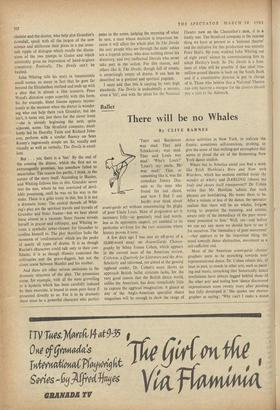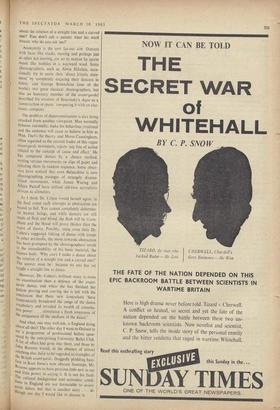Ballet
There will be no Whales
By CLIVE BARNES A few days ago I was sent an off-print of a 10,000-word essay on Avant-Garde Choreo- graphy' by Selma Jeanne Cohen, which appears in the current issue of the American review, Criticism, a Quarterly for Literature and the Arts. Scholarly and informed, yet aimed at the general egghead reader, Dr. Cohen's essay shows an approach British ballet criticism lacks, for the very good reason that the British dance world, unlike the American, has done remarkably little to capture the egghead imagination. A glance at any of the Anglo-American specialist dance magazines will be enough to show the range of dance activities in New York, to indicate the frantic, sometimes self-conscious, probing, to give the sense of that melting-pot atmosphere that seems to cloud the air of the fermenting New York dance studios.
Where but in America could you find a work like Erick Hawkins's Here and Now with Watchers, which has sections entitled inside the wonder of whales and DARLING (shouts my body and shouts itself transparent)? Dr. Cohen writes that Mr. Hawkins 'admits that such phrases are bewildering. He wants them to be. After a minute or less of the dance, the spectator realises that there will be no whales, forgoes trying to pinpoint the meaning, and relaxes, aware only of the immediacy of the pure move- ment presented to him.' Well, yes—and before we can say any more we should have to see it for ourselves. The 'immediacy of pure movement' —that appears to be the important thing, the trend towards dance abstraction, movement as a self-sufficient end.
Most of the American avant-garde choreo- graphers seem to be stretching' towards non- representational dance. 'Dr. Cohen relates this, at least in part, to trends in other arts, such as paint- ing and music, remarking that 'historically, dance revolutions have always lagged behind those of the other arts' and noting how 'dance discovered expressionism some twenty years after painting had fully developed it.' She quotes one choreo- grapher as saying: 'Why can't I make a dance
...)(
about the relation of a straight line and a curved one? You don't ask a painter what his work means; why do you ask me?'
Anonymity is the new far-out aim Dancers with faces like masks, moving and perhaps just as often not moving, are set to motion by sparse music like mobiles in a wayward wind. Some choreographers, such as Alwin Nikolais, occa- sionally try to assist their 'direct kinetic state- ment' by completely encasing their dancers in fabric and George Balanchine (one of the world's two great classical choreographers, but also an honorary member of the avant-garde) described his creation of Stravinsky's A gon as a 'construction in space. comparing it with an elec- tronic computer.
The problem of depersonalisation is also being attacked from another viewpoint. Man normally behaves rationally; make his behaviour irrational and the audience will cease to believe in him as Man. That's the theory, and Merce Cunningham, often regarded as the current leader of this vague avant-garde movement, rejects `any line of action related to the concept of cause and effect.' He has composed dances by a chance method, writing various movements on slips of paper and Selecting them in random sequence. Some obser- vers have noticed that even Balanchine is now choreographing passages of strangely disasso- ciated movements, while James Waring and Aileen Pasloff have utilised old-time surrealistic devices as alienators.
As I think Dr. Cohen would herself agree, in the final count such attempts at abstraction are bound to fail. You cannot completely dehuman- ise human beings, and while dancers are still made of flesh and blood, the flesh will be trium- phant and the blood will prove thicker than the water of theory. Possibly. more even ths'n Dr. Cohen's suggested linking of dance with trends Iii other art-forms, the move towards abstraction has been prompted by the choreographers' revolt at the immalleability of his basic material, the human body. 'Why can't I make a dance about the relation of a straight line and a curved one?' The answer must be: because no one has yet taught a straight line to dance.
However, Dr. Cohen's brilliant essay is more an examination than a defence of the avant- garde dance, and w hen she has finished her Patient pro-ing and con-ing she is left with the conclusion that these new iconoclasts 'have tremendously broadened the range of the dance v.ocabulary and revealed its wealth of connota- tive power . . . stimulated a fresh awareness of the uniqueness of the medium of the dance.'
And what, one may well ask, is England doing about all this? The other day I went to Oxford to see a programme of professional ballets spon- sored by the enterprising University Ballet Club. A lot of effort had gone into them, and those by John Broome would, in the absence of almost anYthing else, have to be regarded as examples of the British avant-garde. Doggedly plodding bare- foot in Kurt Jooss's now obscure footsteps, Mr. Broome appears to have precious little new to say .and little power in saying it. It is not his fault. r.he cultural background and economic condi- tions in England are not favourable to avant- Rarde dance, but that is another story . . . al- though one day I would like to discuss it.
e. Jr es
s.
e- re it it'
a
0- n- at. tt- ce Of ed ng
Ice







































 Previous page
Previous page